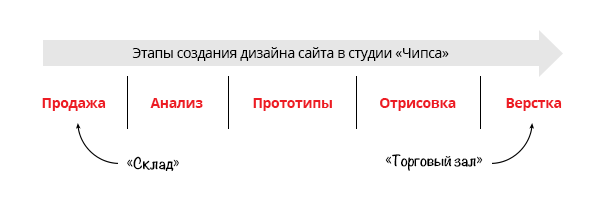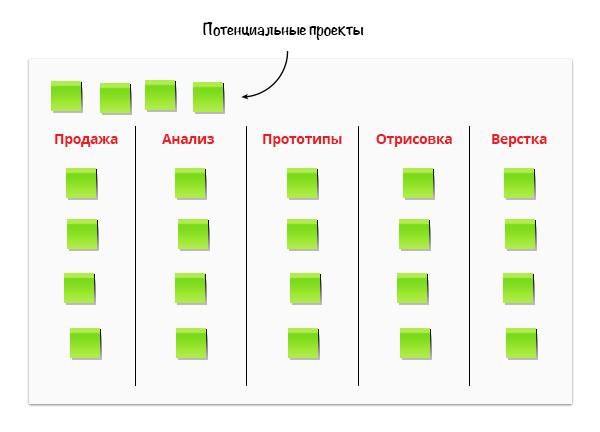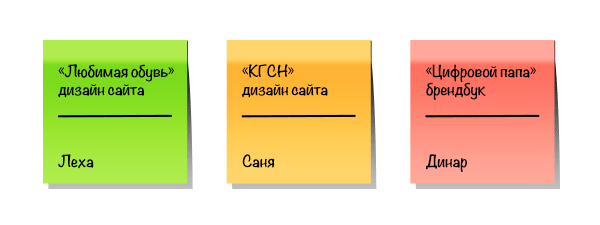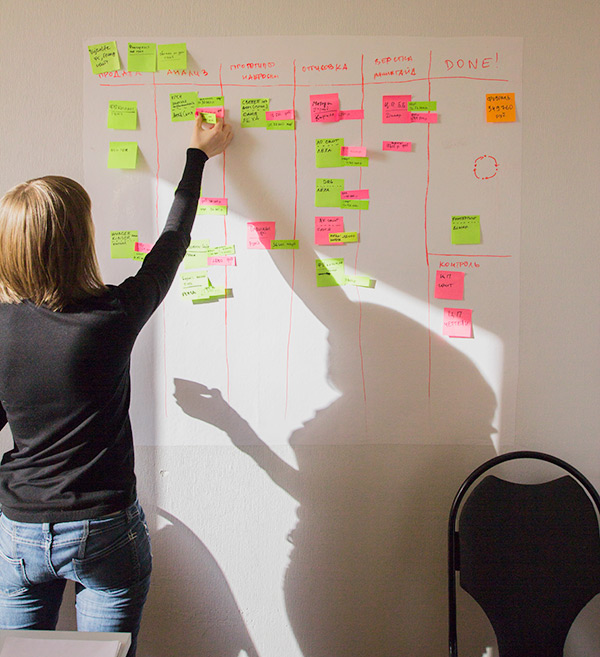Lean. Part 1. Kanban board in a new way.

About three months ago, as the head of a design studio, I was fortunate enough to participate in the wonderful training "Fundamentals of lean manufacturing." This training talked about the methodology of lean. For those who are not in the know, this is the methodology of “degreasing” business processes, which reduces inevitable losses, eliminates useless actions and performs other manipulations aimed at increasing the speed of the company, the number of products or services and, as a result, growth its income. This is if in brief.
What I want to share with you today is the result of realizing only a small part of the knowledge gained at this training. If you are interested in this topic - I am ready to talk about other things that we began to use in our studio after this training. By the way, it is very interesting to read posts on the subject of the lean of our Siberian colleagues - the company Siberiks. Guys, keep it up!
')
So, today we will talk about two components of the wonderful methodology of lean - this is visualization and kanban. The first one says that you need to try to visualize everything and everyone in business processes in order to simplify their perception and understanding. With the second concept, I think many habrayusers have known each other for a long time and not by hearsay. On Habré there were quite a few articles about kanban boards and other similar project management tools. I want to talk about how we discovered the kanban board and how it became useful to us. Perhaps you can learn from our experience and introduce this thing into your company.
Just a bit of theory. On cats apples
If you allow me - I want to give a free description of the concept of "kanban". At least as I understand it. Kanban is a work system that allows you to organize the principle of pulling by the customer. The following illustration shows this system very clearly.

Buyers (customers can say) take the apples from the basket in the supermarket. As soon as the apples in the basket end - the supermarket worker brings a new full basket, which he takes in stock. As soon as the basket has disappeared from the warehouse, the storekeeper puts another one in its place, which he fills with apples from stocks.
The meaning of this approach is that we assess the need to do something based on the real needs of the buyer. In other words, if buyers do not take apples - it makes no sense to bring new baskets from the warehouse, and fill the spare baskets in the warehouse. This is the principle of extrusion. Moreover, it allows you to significantly reduce the time during which there are no apples in the basket on the trading floor. After all, all you need to do is just take them from the previous cell.
Moving from apples in a supermarket to projects in a design studio.
So, what can we get using a kanban board in a design studio?
To begin with, the kanban board is a visualization tool. And we visualize our Kanban cells, which are not physically present. We, for example, broke our business process for creating a website design into the following steps:

We can say that the layout stage is a basket with apples in a supermarket. Drawing, prototyping, analysis and sales - intermediate kanban cells. Stocks in our case are potential projects that need to be processed at the sales stage (in our “warehouse”).
It is not difficult to guess that the ideal state of affairs in the studio is the uniform filling of all kanban-cells with projects. As soon as the customer “pulled out” the project from the layout stage (for us this is the final stage of the site design development) - there is a need to immediately transfer one of the projects that are in the drawing to the layout stage in order to fill an empty cell. Next, fill in the empty cell of the drawing stage with one of the projects, finish making prototypes, etc.

So here. It is for the desire to maintain this ideal state and need a kanban board. It very clearly shows at which of the stages it is necessary to accelerate on any project, and on which there is a “congestion”. And yet - that it is time to think about the fact that there is almost nothing in the warehouse and it's time to do the processing of potential customers.
Our implementation of kanban boards
So, now we understand why we need a kanban board. How do we do it?
We went the easiest way. Pasted directly on the wallpaper in the studio a large white vinyl tape. Marker divided it into stages. Well, in fact, they began to glue stickers with the names of projects on the film.
Over time, they came to the conclusion that on stickers, in addition to the name of the project, it makes sense to write the name of the designer who works on it. This allows you to quickly assess the employment of each designer just a quick glance at the kanban board.

Well, by itself, they introduced a color gradation of stickers. Green - on the project everything is ok. Yellow - it is likely that the project will be delayed at this stage. Red - the project is delayed at this stage, and we must try to do everything to move it to the next stage. The evaluation criterion for “delay” in our case is the deadline of the project. In addition, we strive to transfer to the next stage those projects for which we can get money faster (each stage is paid separately, and the stage payment is divided into an advance and the balance).
We visualized, visualized and not visualized.
As you already understood, we did not stop at what we have achieved. Remember the principle - to try to visualize everything that is possible? So we thought and decided - why not to show the financial flows of the projects on the kanban board? Thus, we will be able to visually see how much money each project will bring when moving to the next stage.
For each sticker, we added a mini-sticker with the amounts that we receive for this project if it is transferred to the next stage. To do this, we write two sums on the sticker - an advance and a balance. And for each amount we indicate the month in which this amount can be received. Thus, we get a kind of financial planning tool, with which we can estimate the approximate total revenue from all projects at the beginning of the month, correlate it with the planned revenue. And evaluate the effectiveness of our work at the end of the month.

The next step suggests itself - color separation for mini-stickers. Yes Yes. Green sticker - payment must be on time. A red sticker - either the customer delays the payment, or it is necessary to put pressure on the project in order to have time to hand over everything by the end of the month, to the salary. As a rule, these are minor edits or revisions. And as you probably already guessed, the number of red mini-stickers by the end of the month often increases significantly :)
Let's sum up
So, what did the introduction of kanban board in our “Chips”?
| Before implementation: | After implementation: |
| There was no clear understanding of how much to sell. There were cases when they took too many projects and could not “chew” them. Or frantically they began to look for orders when they suddenly realized that the projects were about to end. | Visualization of projects using kanban boards and the principle of extrusion makes it easy to assess the need to process a potential client, transfer a stale, non-urgent project to the next stage, etc. |
| To assess the employment of designers have tried many tools, including guglotablitsu. She was not very visual. Her management took a lot of time. | To assess the employment of the designer for the next two months, just look at the board, count the number of stickers with the designer's name and understand how much it is loaded and when it is free. |
| There were moments when it was not clear at what stage of the business process we have a weak link, so to speak. | Now clearly visible at what stage there is a problem. It remains to find it and solve it. |
| I must admit that before the introduction of kanban boards, we were not engaged in monthly financial planning. It so happened that we began to conduct it in parallel with the introduction of kanban boards. | A simple but fairly effective financial planning tool. Yes, it allows you to look only 2-3 months in advance. But it is very clear. And the cash flow can actually be influenced by making every effort to the "necessary" projects. |

I think it is worth noting some "options" of our small Krasnoyarsk studio. We have 5 designers, 1 project manager and 1 art director. We strive to ensure that one designer performs at least 2 projects simultaneously. Kanban board use the third month. Very pleased with this tool! :)
I hope you will benefit from all that I have described here. I would be glad if this article will help you in such a difficult task as project management! )
Source: https://habr.com/ru/post/171727/
All Articles